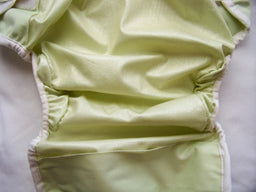Cloth diaper laundry involves a trade-off between cleaning diapering items thoroughly and making them last. Whether the product has natural components or man-made components determines the care of the product. This is just like your other laundry - it must be sorted with special care as to the content of the item. You may wash your Thirsties items together on Hot (after the initial prep cycles), but drying does need some special attention.
Fact: Drying with heat damages the fibers of any material.
Anyone who owns a wool diaper cover knows that they would never put it in the washer or dryer with their other diapering items. Much the same, diapers and covers with man-made components must be kept out of high heat, or the items will quickly break down. You will see evidence of wear as fading color, tears, weakened seams, stretched out elastic, and hook and loop that no longer holds. Components containing spandex or other elastic materials can become permanently stretched out or warped by regular full-heat drying cycles over time.
Fact: Lint is actually fibers that come out of the fabric in the washer and dryer!
Take a look at the elastic on the diapering products below. Example 1: This one was routinely dried in the dryer on high. The Fold Over Elastic is all stretched out. The diaper lays almost flat when open.
Example 2: The one below was hung to dry. The elastic is still stretchy. It gently curls the edges and gathers the fabric.
As for the hook and loop, high heat relaxes the hooks that hold on to the loop portion. If the hooks are relaxed, they will not be able to keep their grip. It would become like a fish hook that is straight. The loop portion can also become fuzzy making it difficult to keep a firm hold. Take a look at the two examples below. The top diaper was dried on high heat routinely. The bottom was air dried.
Personal Note: Now, these two diapering items are from my personal stash. I dried all of my AIO diapers on high after each wash, for about 60 minutes. The elastic and the Aplix fasteners failed within 6 months. My covers that were air dried did not. Although my children have since potty trained, I keep one sample of each diaper that I used on hand for research/reference purposes. Believe me; air drying does make a big difference! Thirsties
recommendations for drying diapering products are as follows:
- Hang your cloth diapers to dry or dry in the dryer on low. Inserts, flats, and prefolds may be dried on higher settings.
- Add a dry towel or wool dryer balls to the dryer to speed the drying process.
- A hot, 15 minute dryer cycle once a month is beneficial to lamination.
- Drying in direct sunlight is the very best method for drying and disinfecting, and at getting rid of stains. However, take care not to leave diapers out longer than necessary, as UV rays and high temperatures can also have an ill effect on diapering products. Cotton and hemp diapers will be somewhat stiff when hung to dry. One option to soften sun-dried textiles made from natural fibers is to use the dryer while still slightly damp.
A general rule to remember is:
- Covers should be air dried.
- Pockets, fitteds, and AIOs should be air dried or dried on low heat.
- Your natural fiber prefolds, flats, inserts, and wipes can be dried on higher heat settings.
Happy cloth diapering!
Written by Sonya Choron 12/14/11









AAaak the dried cover looks terrible!
Thanks for the tips. Wish there was more sun in the winter. Although in Oregon the weather changes every 5 minutes so it really keeps me on my toes.
Since I moved into my house and got my own washer and dryer, I have been drying my cloth diapers in the dryer more than line drying like I did before. This post inspired me to start line drying my diapers more often!
I’ll also be drying our beloved fitteds on the rack from now on. :)
Thanks for the great post. I always air-dry my pocket diapers and covers but for some reason had never even thought about air-drying my fitted diapers. I definitely will from now on.
You're viewing 1-5 of 19 comments